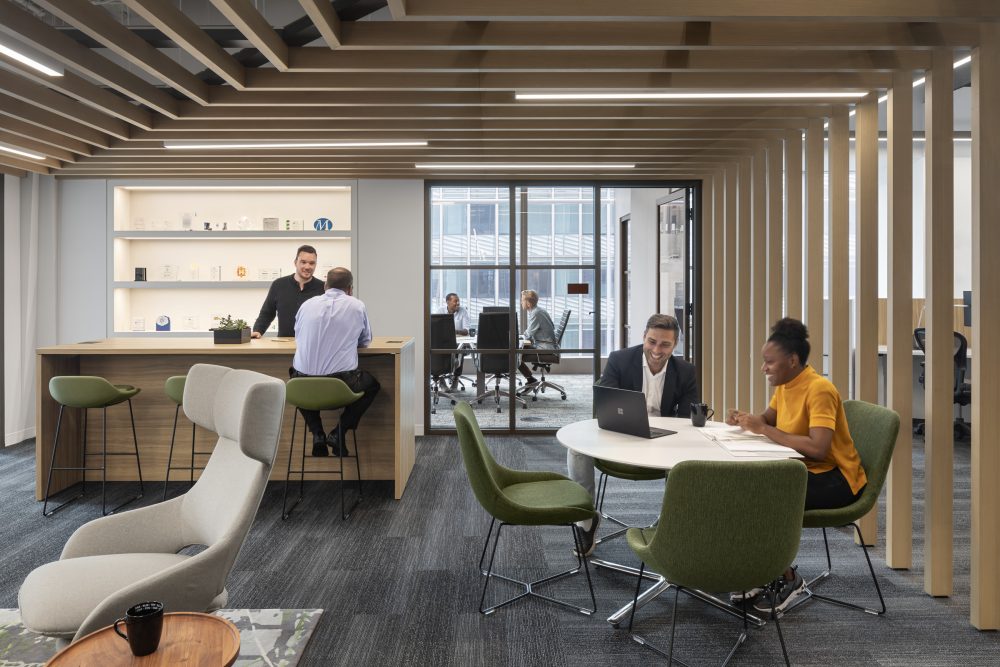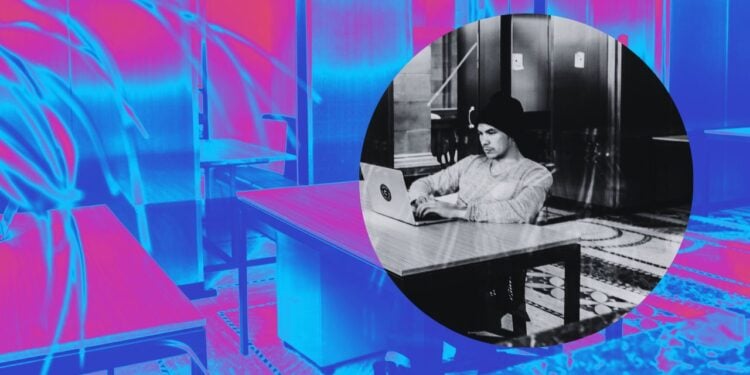- Surveys show that hybrid and remote workers feel lonelier and have fewer friends on the job.
- Now that offices are open for business, there’s an eagerness to boost in-person engagement and rebuild working relationships.
- The built environment shapes behaviors. Things like proportion, scale, acoustics, lighting, colors, and layout affect how people feel, behave, and interact in a space.
This article was written by the Perkins Eastman Design Strategy team for Work Design Magazine.
Workplace friendships took a hit during COVID. Surveys show that hybrid and remote workers feel lonelier and have fewer friends on the job, and yet, these relationships carry more weight than ever before. Having a close friend at work increases productivity, retention, and workplace satisfaction, among other benefits.
Meet me at the water cooler
Now that offices are open for business, there’s an eagerness to boost in-person engagement and rebuild working relationships. Even for seasoned remote teams, it’s hard to match the bonding that comes with seeing the same familiar faces in the office pantry each morning or chatting about weekend plans at the copy machine. Rapport — positive, genuine connection — develops in ordinary and repeated moments of actual human contact.
Unfortunately, getting back to “normal” isn’t as simple as reinstating pre-COVID work policies.
The built environment is a stage for human activity, but it also shapes behaviors. Things like proportion, scale, acoustics, lighting, colors, and layout affect how people feel, behave, and interact in a space. Just as a well-considered workplace can foster connection and belonging, one that is poorly designed can contribute to isolation, conflict, and decreased productivity.

What is rapport?
Rapport is about building positive, meaningful relationships that are enjoyable and productive. It hinges on reciprocity, trust, communication, and genuine human interest. At work, rapport can exist between individuals, within and among teams, or between employees and their employer.
Rapport is good for business
Employees who feel connected to their coworkers and company are more engaged in their work, less likely to switch jobs, and report higher levels of satisfaction. They are also more productive: a 2019 study on behavioral management found that participants in a rapport-building work group completed significantly more productivity tasks and scored higher on discretionary effort. In other words, they tried harder and accomplished more.
It’s not (just) about proximity
Face time can be great, but putting people together in an office doesn’t mean they will connect with each other or with their organization. Physical proximity creates an opportunity for rapport, but, when it comes to building relationships, there are other factors at play.
Three ideas to foster rapport in the workplace
1. Collaboration takes many forms
Different kinds of collaboration call for different tools and settings. In the office, use digital and physical strategies to support rapport-building, like installing a pin-up board to celebrate team “wins,” carving out a dedicated team workspace for the duration of a project, incorporating writeable surfaces on desks and walls, or outfitting conference rooms with digital collaboration tools that can be hidden away when they’re not in use.
2. Familiarity promotes fondness
Humans tend to prefer people and things that are familiar to them. Social scientists call this the mere exposure effect, and it means that we generally find people to be more likable through repeated contact. By design, we can turn this tendency to good use by manipulating paths of travel to encourage chance meetings and walk-and-talk conversations. Strategically placed amenities like coffee bars and snack stations can be used to influence traffic flow and prompt spontaneous encounters.
3. Aw! Is that your puppy?
It’s debatable whether employees should bring their “whole self” to work, but a little humanity can go a long way towards building rapport with coworkers. Tacking up photos of family members or pets, changing your desktop wallpaper to an image that makes you happy, or displaying a souvenir from your recent trip to Barcelona can act as a conversation-starter and make your workspace feel a little brighter.


 Dr. Gleb Tsipursky – The Office Whisperer
Dr. Gleb Tsipursky – The Office Whisperer Nirit Cohen – WorkFutures
Nirit Cohen – WorkFutures Angela Howard – Culture Expert
Angela Howard – Culture Expert Drew Jones – Design & Innovation
Drew Jones – Design & Innovation Jonathan Price – CRE & Flex Expert
Jonathan Price – CRE & Flex Expert












